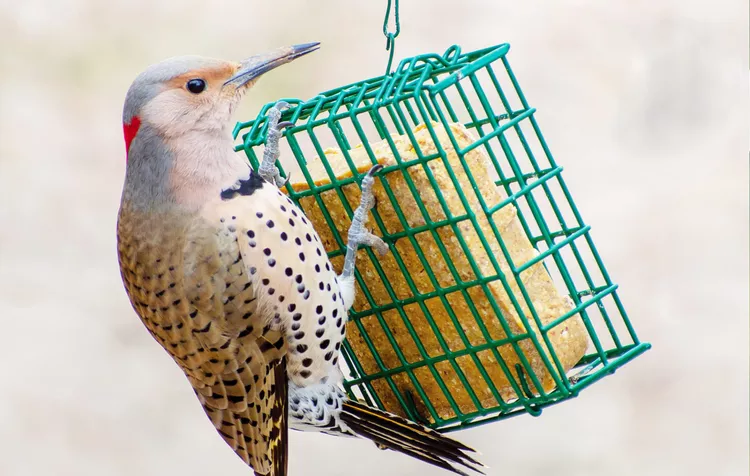It takes lots of energy for wild birds to stay warm in winter. You can help them by serving up suet for birds, a high-fat food that provides the extra calories birds need when temperatures drop. Traditionally, suet is made of rendered beef fat, though other fats, including vegetable fat, can be used. Bird-friendly goodies, such as seeds, nuts, nut butter, cracked corn or corn meal, oats, dried fruit, and/or mealworms are mixed with the fat to add nutrition and appeal. These ingredients are usually formed into suet cakes that can be purchased ready-made, or you can easily make your own. Here's what you need to know about feeding birds suet.
Which Birds Does Suet Attract?
While many birds are attracted to this high-energy food source, some are regular visitors to feeders containing suet for birds. "Woodpeckers are most frequently seen feeding on suet; downy woodpeckers, hairy woodpeckers, red-bellied woodpeckers, northern flickers, and if you're very lucky, pileated woodpeckers," says Gwendolyn Causer, environmental educator with Audubon Vermont. "You'll also attract insect-loving birds, such as black-capped chickadees, tufted titmice, white-breasted nuthatches, and Carolina wrens," she adds.
Store-Bought or Homemade Suet for Birds?
Though cakes are the most-common form of commercial suet, it's available in other shapes suited to different feeders. And ingredients vary; some are designed to attract specific birds. 'No-melt' suet, with added grains or flour, is a good option for warmer weather when suet can soften. Birds who discover your suet will often feed with gusto; they can polish off a cake in less than a week, so you may want to stock up on suet by the case ($13, Walmart) to be sure you have plenty on hand.
Or, make your own suet for birds using simple recipes. "Homemade suet cakes are not difficult to make and offer birdwatchers the ability to customize their suet cakes with the freshest, additive-free ingredients," says conservation biologist Aimee Tomcho of Audubon North Carolina.
Making suet for birds is a fun family activity; kids will enjoy watching birds eat what they cook up. After your ingredients are mixed, spoon the suet into plastic containers or ice-cube trays or form it into whatever shape and size works best to fit your feeders. To keep it fresh, store suet for birds in the freezer until you're ready to serve it up for feathered visitors.
Don't fret if birds don't flock to your suet-stocked feeders right away; it may take a few days for them to discover this healthful treat. Once they do, there will likely be steady activity as long as the suet lasts.
Suet for Birds Feeding Tips
Suet cakes (about four inches square and an inch-and-a-half thick) fit easily into an inexpensive metal suet cage ($4, The Home Depot). Balls or nuggets of suet can be hung in "suet socks," which are mesh polyester bags ($3, Duncraft) that are favored by smaller, clinging birds. A log with drilled holes filled with suet pellets ($5, Walmart) provides a natural perch for birds while they feed. These can be purchased ready-made, or you can make your own.
More elaborate suet feeders are also available. Some hold several cakes at once; some have a "tail prop" to support birds while they eat or barriers for squirrels. Upside-down suet feeders ($30, Etsy) discourage starlings and grackles, who can become bullies at the feeder.
Locating suet in the right spot in your yard will attract more birds and keep them safe while they eat. "Place the suet feeder well off the ground to keep out predators and squirrels," says Causer. "Birds will also feel more at ease if the feeder is not near dense bushes," she adds. Ideally, feeders should be situated at least 10 to 12 feet away from shrubs or trees. To prevent harmful window collisions, place feeders within 3 feet of a window or more than 30 feet away.
When to Put Out Suet for Birds
Although wild birds will eat suet year-round, it's most important to offer it to them in fall and winter "since it's such an excellent source of energy for birds when they're burning tremendous amounts of calories just to keep warm," says Causer.
Suet stays fresh for quite a while during cold weather, but in summer it can become rancid before it's consumed. "Keeping suet fresh is the key to success if you do decide to keep it out in warmer weather," says Tomcho, who adds, "You can tell if suet has gone bad if it has an unappealing odor. Your best clue is to observe bird behavior: Have they stopped feeding on the suet?" If so, it's probably time to replace it.
Draw Birds to Your Backyard with These Guides
Nature lovers and bird-watchers who want as many visitors as possible can attract birds to your garden by following these tips.




















